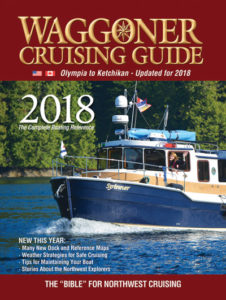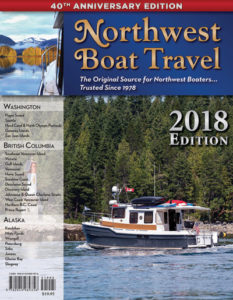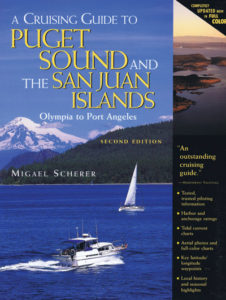Puget Sound, San Juan Islands, and Gulf Islands offer a lifetime of cruising for any boater. There are hundreds of islands, over a thousand miles of shoreline, countless bays and harbors, numerous passes and canals, with marinas and small waterfront towns punctuating it all.
Even for those of us who grew up plying the waters of Puget Sound, there is always something new to be discovered. Charts and GPS can help you safely navigate the area, but a good guidebook or two will make your trip planning and adventures even more rewarding.
A good cruising guide has to offer something you can’t get from a simple chart. It must function as a fun read while tied to the dock on a cold, dark night, and it has to be easy to use while underway. I spend as much time thumbing through the pages of my cruising guide while dreaming of our next adventure as I do relying on them to supplement information on my charts. A good guide is well-written and accurate.
There are a number of guidebooks out there. Which one works for you is a matter of need and taste. Here are three of my favorites for you to consider.
The Waggoner Cruising Guide
 The Waggoner Cruising Guide is an annual publication that hits the shelves early each year. The large format paperback can feel a lot like a magazine with the page layouts and numerous ads, but the guide is well-designed, logically organized, and easy to read.
The Waggoner Cruising Guide is an annual publication that hits the shelves early each year. The large format paperback can feel a lot like a magazine with the page layouts and numerous ads, but the guide is well-designed, logically organized, and easy to read.
The amount of information about marinas and anchorages in the Waggoner is astonishing and at times overwhelming, but it is incredibly readable. The opening section of the guide is full of important information on geography, anchoring, fitting out a boat, and navigating our confusing waterways. For someone coming to the Northwest to charter, the Waggoner should be required reading, as it provides an excellent overview of the area and its idiosyncrasies.
Of note in the Waggoner Guide are the excellent first-person narratives about unique cruising challenges and adventures, often penned by readers and users of the guide. These sidebars give the guide its voice and flavor and elevates it well beyond a “yellow pages” of boating in the Northwest.
We keep the most recent edition of the Waggoner onboard at all times. When pulling into an unfamiliar port or marina it provides us the quick information we need to contact harbormasters or make sense of channel markers and difficult approaches. By early spring each year our copy is already heavily dog-eared and annotated.
Northwest Boat Travel
 Northwest Boat Travel is another annual publication that provides almost encyclopedic information on destinations and facilities from Olympia to Skagway. Replete with ads and full color charts and photos, Northwest Boat Travel is easy to use and well laid out. Many mariners use the annual publication to begin planning trips up the Inside Passage, and it is excellent for providing overviews of the different cruising grounds of Puget Sound and beyond.
Northwest Boat Travel is another annual publication that provides almost encyclopedic information on destinations and facilities from Olympia to Skagway. Replete with ads and full color charts and photos, Northwest Boat Travel is easy to use and well laid out. Many mariners use the annual publication to begin planning trips up the Inside Passage, and it is excellent for providing overviews of the different cruising grounds of Puget Sound and beyond.
Northwest Boat Travel emphasizes information. Many of the entries are written by the owners or operators of the marinas or facilities the book features, so there isn’t a consistent voice or style. This makes it less “readable” than some other guides but in terms of pure nautical information it is hard to beat.
The color schematics of marinas and ports of call are very helpful, especially when pulling into an unfamiliar port for the first time. Locals provide good information on approaches and dangers, and there is plenty of “insider” knowledge to be had.
This guide belongs on any cruiser’s nav table. You will find yourself referring to it often as you plan your next big trip or just tomorrow’s port of call. The best thing about such a complete informational resource is the confidence it gives you to try an out-of-the-way spot or less popular port of call.
A Cruising Guide to Puget Sound and the San Juan Islands
 The second edition of Migael Scherer’s comprehensive cruising guide is one of the most enjoyable reads and indispensable resources in the cruising guide community. Spiral bound, it is meant to be used in concert with your navigational charts for trip planning and navigation.
The second edition of Migael Scherer’s comprehensive cruising guide is one of the most enjoyable reads and indispensable resources in the cruising guide community. Spiral bound, it is meant to be used in concert with your navigational charts for trip planning and navigation.
Scherer’s guide covers the waters from Olympia to the San Juan Islands, so if your travel plans will take you across the border into the Gulf Islands, you will need another guide. The sole focus on the U.S. waters of the Salish Sea allows her to give more detailed information, full color chart reproductions, and stunning photographs. The addition of aerial photographs gives skippers a bird’s eye view of channels and approaches, which is incredibly helpful for first-time visits.
The navigation advice and other information is knowledge acquired by Scherer herself, and she provides honest and helpful tips along with personal experiences. The introductory information covers topics from weather to tying to a state park mooring.
Her simple rating system for anchorages and destinations helps you plan a trip so you don’t miss the highlights. I have found her descriptions to be spot on, and we have dropped anchor in secluded coves we would otherwise have cruised right past. Scherer’s experience is confidence-inspiring.
The book includes several very useful appendices and several interesting sidebars on things like drawbridges in Lake Washington and navigating around Washington State Ferries. Scherer’s instructions for navigating the Ballard Locks are the best I’ve seen, and if you are making that trip for the first time I strongly recommend reading and studying her explanations.
There is room for all three of these guides on both your nautical bookshelf and nav table. They each fit a unique need and they are all very useful and interesting.